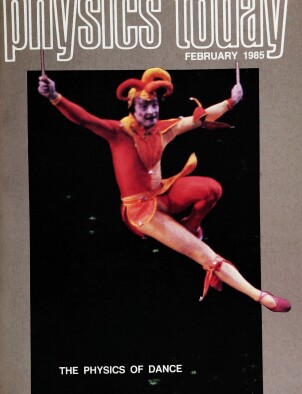Ultra‐High‐Current Electron Induction Accelerators
DOI: 10.1063/1.881001
To probe deeper into the subnuclear structure of matter, physicists over the last 50 years have developed a remarkably sophisticated technology of high‐energy accelerators. By design, these accelerators have operated at relatively low currents, primarily to avoid complications due to electric fields generated by the charged‐particle beams themselves. Machines such as the linear accelerator at Stanford University (SLAC) produce electron beams with energies as high as 32 GeV and peak currents of about 120 milliamps. Although of fairly low current, these devices have proven extremely successful in high‐energy physics experiments, where one can irradiate a target over an extended period of time to get a statistically significant number of collisional events.
This article is only available in PDF format
References
1. H. H. Fleischmann, PHYSICS TODAY, May 1975, page 34;
J. A. Nation, Part. Acc. 10, 1 (1979).2. J. Golden, C. A. Kapetanakos, J. A. Pasour, R. A. Mahaffey, Am. Sci. 69, 173 (1981).https://doi.org/AMSCAC
3. C. A. Kapetanakos, P. Sprangle, NRL Memo Report number 5259, Naval Research Laboratory, Washington, D.C. (1984).
4. N. C. Christofilos, R. E. Hester, H. A. S. Lamb, D. D. Reagan, H. A. Sherwood, R. E. Wright, Rev. Sci. Instrum. 35, 886 (1964); https://doi.org/RSINAK
J. E. Leiss, N. J. Norris, M. Wilson, Part. Acc. 10, 223 (1980);
D. Keefe, Part. Acc. 11, 187 (1981);
T. J. Fessenden, W. A. Atchinson, D. L. Birk, R. J. Briggs, J. C. Clark, R. E. Hester, V. K. Weil, A. C. Paul, D. Rogers Jr., K. H. Struve, in Proc. Int. 4th Top. Conf. High‐Power Electron and Ion‐Beam Research and Technology, H. J. Doucet, J. M. Buzzi, eds., Laboratoire de Physique des Milieux Ionises, Ecole Polytechnique, Palaiseau, France (November 1981) p. 813;
R. Briggs in Proc. 1981 Particle Accel. Conf. IEEE Trans. Nucl. Sci. NS‐28, 3360 (1981).https://doi.org/IETNAE5. A. I. Pavlovskii, V. S. Bosamykin, V. A. Savchenko, A. P. Klement’ev, K. A. Morunov, V. S. Nikol’skii, A. I. Serasimov, V. A. Tananakin, V. F. Basmanov, D. I. Zenkov, V. D. Selemir, A. S. Fedotkin, Dok. Acad. Nauk SSSR 250, 118 (1980) https://doi.org/DANKAS
[A. I. Pavlovskii, V. S. Bosamykin, V. A. Savchenko, A. P. Klement’ev, K. A. Morunov, V. S. Nikol’skii, A. I. Serasimov, V. A. Tananakin, V. F. Basmanov, D. I. Zenkov, V. D. Selemir, A. S. Fedotkin, English translation in Sov. Phys. Dokl. 25, 120 (1980)].https://doi.org/SPHDA96. K. R. Prestwich, D. E. Hasti, R. B. Miller, A. W. Sharpe, IEEE Trans. Nucl. Sci. NS‐30, 3155 (1983).https://doi.org/IETNAE
7. L. N. Kazanskii, A. V. Kislestov, A. N. Lebedev, At. Ener. 30, 27 (1971).https://doi.org/AENGAB
8. M. Friedman, Appl. Phys. Lett. 41, 419 (1982).https://doi.org/APPLAB
9. D. W. Kerst, Nature 157, 90 (1940).https://doi.org/NATUAS
10. A. I. Pavlovskii, G. D. Kuleshov, A. I. Serasimov, A. P. Klement’ev, V. O. Kuznetsov, V. A. Tananakin, A. D. Tarasov, Zh. Tekh. Fiz. 47, 370 (1977) https://doi.org/ZTEFA3
[A. I. Pavlovskii, G. D. Kuleshov, A. I. Serasimov, A. P. Klement’ev, V. O. Kuznetsov, V. A. Tananakin, A. D. Tarasov, English translation in Sov. Phys. Tech.‐Phys. 22, 218 (1977)].https://doi.org/SPTPA311. P. Sprangle, C. A. Kapetanakos, J. Appl. Phys. 49, 1 (1978); https://doi.org/JAPIAU
N. Rostoker, Comments Plasma Phys. 6, 91 (1980);
C. A. Kapetanakos, P. Sprangle, D. P. Chernin, S. J. Marsh, I. Haber, Phys. Fluids 26, 1634 (1983).https://doi.org/PFLDAS12. P. Sprangle, D. Chernin, Part. Accel. 15, 35 (1984).https://doi.org/PLACBD
13. C. Roberson, A. Mondelli, D. Chernin, Phys. Rev. Lett. 50, 507 (1983).https://doi.org/PRLTAO
14. D. P. Taggart, M. R. Parker, H. J. Hopman, R. Jayakumar, H. H. Fleischmann, Phys. Rev. Lett. 52, 1601 (1984).https://doi.org/PRLTAO
More about the Authors
Chris A. Kapetanakos. Naval Research Laboratory, Washington, D.C..
Phillip Sprangle. Naval Research Laboratory, Washington, D.C..




